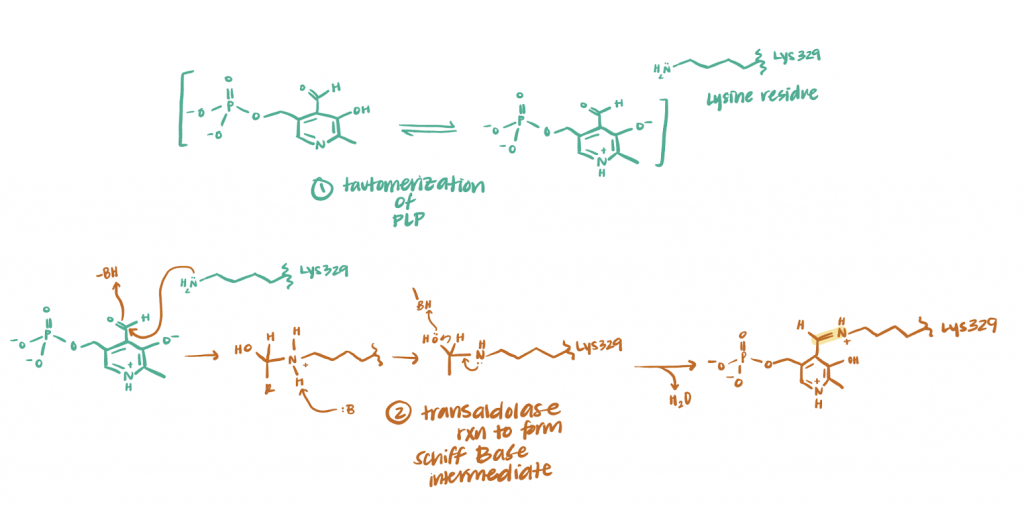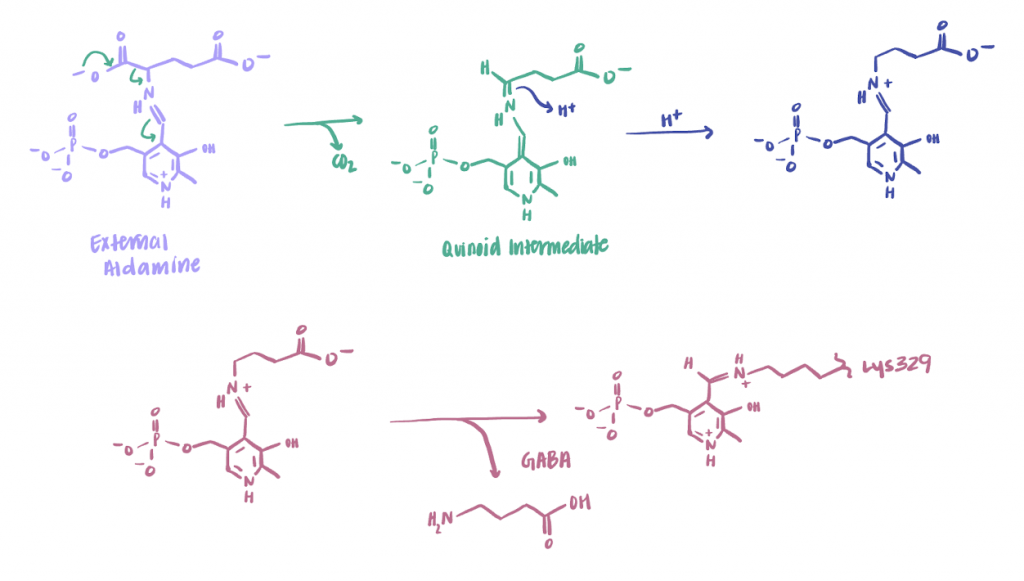The electron pushing mechanism below demonstrates the reaction of glutamate to GABA through the enzyme glutamic acid decarboxylase with the pyridoxal phosphate (PLP) as the cofactor. This reaction irreversibly produces GABA from glutamate, which is important as this reaction directly controls the levels of the neurotransmitter in the brain, which (as described earlier) has a direct impact on sleep (24).

The PLP cofactor is covalently attached to the enzyme via a Lysine residue. The cofactor’s aromatic system creates an electron sink that allows for the desired decarboxylation reaction to occur simply. Additionally, PLP allows for coordination in the enzyme’s active site allow for proton transfers and allows for GABA to be cleaved and released from the active site easily.
The reaction begins with glutamate deprotonated at the body’s pH (~7.5). Then the double bond of PLP attacks the positively charged nitrogen of glutamate to form the intermediate given in the first line. Immediately, the lysine side chain leaves to allow for the decarboxylation reaction (24).
The electrons from the carbon dioxide are pushed around the aromatic system as seen in the external aldamine figure below. This level of conjugation allows for decarboxylation to occur very easily. After a proton transfer occurs to regenerate aromaticity, the lysine residue from earlier is used in a similar manner to the first step of this mechanism to displace the newly-formed GABA and regenerate the cofactor.

This reaction above is part of what is known as the GABA shunt. The reaction begins when α-ketoglutarate from presynaptic neurons leaves the mitochondria and is converted into L-glutamate by GABA-T. L-glutamate is eventually converted into GABA by glutamate decarboxylase as shown above (24).
GABA is an inhibitory neurotransmitter that plays an important role in sleep. If there was something deficient with this mechanism, it could disturb the levels of GABA and potentially cause problems within the body (24).
This mechanism occurs upstream from the pathway discussed yet is extremely important to the therapeutic response. The GABA receptor is targeted by drugs to promote GABA activity. That requires an increase in concentration of GABA which shifts the equilibrium in favor of more GABA production through this mechanism (24).
I think this is a concise section on the discussion of glutamate decarboxylase. However, I think since glutamate decarboxylase is the main enzyme the produce GABA, I think this should main discussion in the GABA-T section. The product of succinate-aldehyde by the attack GABA seems irrelevant to the regulation of sleep since we need GABA molecules to induce hyper-polarization for inhibition. Therefore, I would suggest organization between the information of the two sections of the mechanism (since there are many overlap). More specifically, make glutamate decarboxylase as the main focus of mechanism.
Same as before. Nice job!
i think that you could break the figures up so that they are in line with the paragraphs in which they are discussed. this will allow for easy referral to your figures and an easier understanding of what is occuring.
Good explanation of the GABA shunt, but I think the figures are kind of just sitting on the page right now. In-text citations of the figures will be helpful and easier to follow. For now, I’m not quite sure when to look at the figures.
Another small note, the citations in the figure descriptions aren’t linked to the citation page.
The page is overall great. Only two things to improve on. The first is very minor but the first paragraph alludes to a figure above, however, there is no figure above and the figure number is not listed. The other minor improvement would be altering the structure slightly. I think the second to last paragraph which resummarizes GABA could be included but not there (maybe first) or just don’t include the paragraph. Also the last paragraph would benefit from a more clear conclusion.
Thank you for your comments. All of the language was adjusted to better direct the reader to each image and mechanism. Also, the figures were broken down to improve the flow of the page!